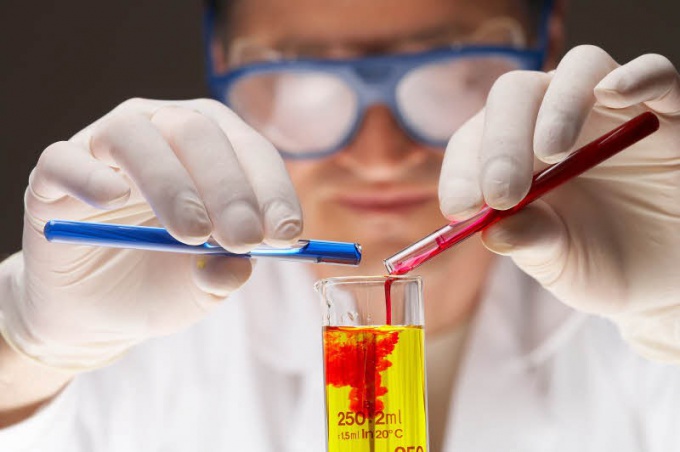Qualitative reactions for cations and anions
To determine the cation of silver necessary to carry out the reaction with some chloride. The interaction of Ag(+) and Cl(-) resulted in a white precipitate AgCl↓. The barium cations Ba2+ are found in the reaction with sulfate: Ba(2+)+SO4(2-)=BaSO4↓ (white precipitate). Equally the opposite is true: to detect in solution the chloride ions or sulfate ions, it is necessary to carry out the reaction, respectively, with salts of silver and barium.
For the determination of cations Fe(2+) using hexacyanoferrate (III) potassium K3[Fe(CN)6], and more precisely, the complex ion [Fe(CN)6](3-). The resulting dark blue precipitate Fe3[Fe(CN)6]2 is called "turnbulls blue". For the detection of iron cations (III) take hexacyanoferrate (II) potassium K4[Fe(CN)6], which gives the interaction with Fe(3+) dark blue precipitate Fe4[Fe(CN)6]3 – Prussian-blue. To detect Fe(3+) can also in the reaction with ammonium thiocyanate NH4CNS. The result is multisociety the thiocyanate iron (III) – Fe(CNS)3 and the solution becomes blood-red.
An excess of hydrogen cations H+ creates an acidic environment in which respectively change color of led: orange methylorange and purple litmus turn red. In excess of the hydroxide ions OH- (alkaline medium) litmus turns blue, methylorange – yellow, and colorless in neutral and acidic conditions, the phenolphthalein becomes a crimson coloration.
To understand whether the solution is the ammonium cation NH4+, need to add alkali. With a reversible interaction with the hydroxide ions NH4+ ammonia NH3↑ and water. Ammonia has a characteristic smell and a wet litmus paper in this solution it will turn blue.
In the qualitative reactions for the ammonia reagent used HCl. In the process of formation of ammonia and hydrogen chloride ammonium chloride HN4Cl you can watch the white smoke.
Carbonate and hydrogen carbonate ions CO3(2-) and HCO3(-) can be detected by adding acid. The interaction of these ions with cations of hydrogen produces carbon dioxide and water is formed. By passing the gas through lime water Ca(OH)2 solution becomes cloudy as insoluble compound is formed – calcium carbonate CaCO3↓. Upon further transmission of carbon dioxide is formed acidic salt is already soluble calcium hydrogen carbonate Ca(HCO3)2.
Reagent for the detection of sulfide ions S(2-) – soluble lead salt, producing a reaction with S(2-) black precipitate of PbS↓.
Detection of ions with the torch
Salts of certain metals, when introduced into the flame to paint it. This property is used in qualitative analysis for the detection of cations of these elements. Thus, Ca(2+) colors the flame in a brick red, Ba(2+) - yellow-green. Combustion of potassium is accompanied by a violet flame, lithium – bright red, sodium yellow, strontium – Carmine-red.
Qualitative reactions in organic chemistry
Compounds with double and triple bonds (alkenes, alkadienes, alkyne) discolor red-brown bromine water Br2 and pink solution of potassium permanganate KMnO4. Substances with two or more gidroksipropil -OH (polyhydric alcohols, monosaccharides, disaccharides) are dissolved in the alkaline environment of freshly-prepared blue precipitate of Cu(OH)2, forming a solution of bright blue color. Hydroxide copper (II) also react with aldehydes, aldose and reducing disaccharides (aldehyde group), but there falls a precipitate of Cu2O↓ brick red color.
Phenol in a solution of iron (III) chloride forms a complex compound with FeCl3 gives violet coloration. Substances that contain aldehyde group, a reaction of "silver mirror with ammoniacal solution of silver oxide. The solution of iodine with the introduction of starch turns purple, and the peptide bonds of proteins detected in reactions with saturated copper sulfate solution and concentrated sodium hydroxide.
